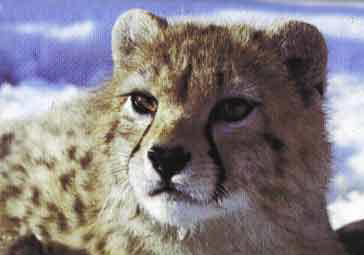|
| 질의: indian wild cat | 결과: 29번째/44 | |
Asiatic Cheetah (Acinonyx jubatus venaticus) - Wiki
| 제목: | Asiatic Cheetah (Acinonyx jubatus venaticus) - Wiki
| |

| 해상도: 364x255
파일크기: 14498 Bytes
등록시간: 2007:07:02 14:02:49
|
Asiatic Cheetah
From Wikipedia, the free encyclopedia
[Photo] Asiatic Cheetah. From: http://www.iraniancheetah.org/photogallery.htm Copyright ?? 2003-2004 Iranian Cheetah Society (ICS)
The Asiatic Cheetah ("cheetah" from Hindi ???????????? c??t??, derived from Sanskrit word chitraka meaning "speckled") (Acinonyx jubatus venaticus), also known as the Iranian Cheetah is a rare critically endangered subspecies of the Cheetah found primarily in Iran. It is an atypical member of the cat family (Felidae) that hunts by speed rather than by stealth or pack tactics. It lives in a vast fragmented desert and although recently extinct in India it is also known as the Indian Cheetah. It is the fastest of all land animals and can reach speeds of up to 70 mph (112 km/h). The Cheetah is well known for its amazing acceleration (0-100 km/h in 3.5 seconds which is faster than some supercars. It is now on the verge of extinction, as only 60 to 100 are estimated to exist.
Anatomy and morphology
Head and body, the adult Asiatic Cheetah measures from 112-135 cm with a tail length between 66-84 cm. It can weigh from 34-54 kg, but the male is slightly larger than the female.
Ecology and life history
Habitat
Cheetahs thrive in open lands, small plains, semi-desert areas and other open habitats where prey is available. The Asiatic Cheetah is found in the Kavir desert region of Iran, which includes parts of the Kerman, Khorasan, Semnan, Yazd, Tehran and Markazi provinces. The Asiatic Cheetah also seems to survive in the dry open Balochistan province of Pakistan where adequate prey is available. The cheetah's habitat is under threat from desertification, increasing agriculture, residential settlements and declining prey - caused by hunting and degradation in pastures by overgrazing from introduced livestock.
Feeding ecology
The Asiatic Cheetah preys on small antelopes. In Iran, it feeds mainly upon the Goitered and the Jebeer Gazelle, and sometimes even rabbits and rodents. In India fifty years ago, prey was abundant, and it fed upon the Blackbuck, the Chinkara and sometimes even the Chital and the Nilgai.
Evolutionary history
The Asiatic Cheetah once ranged from Arabia to India, through Iran, central Asia, Afghanistan and Pakistan and, particularly in Iran and Indian subcontinent, it was numerous. Cheetahs are the only big cat that can be tamed and trained to hunt gazelle. The Mughal Emperor of India, Akbar, was said to have had 1,000 cheetahs at one time, something depicted in many Persian and Indian miniature paintings.
By the beginning of the twentieth century, the species was already heading for extinction in many areas. The last physical evidence of the Asiatic Cheetah in India was three shot (with two bullets) by the Maharajah of Surguja in 1947 in eastern Madhya Pradesh. By 1990, the Asiatic Cheetah appeared to survive only in Iran. Estimated to number more than 200 during the 1970s, more recently Iranian Biologist Hormoz Asadi estimated that the number of Asiatic Cheetahs left to be between 50 and 100 and figures for 2005-2006 are between 50 and 60 in the wild. Most of these 60 Asiatic Cheetahs live in Iran on the Kavir desert and a remnant population inhabits the dry terrain covering the border of Iran and Pakistan. In the areas in which the cheetah lives locals say they have not seen it for more than fifteen years.
Conservation
Following the Revolution of 1978, wildlife conservation was given a lower priority; the Asiatic Cheetah and its principal prey, gazelles, were hunted, resulting in a rapid decline. As a result, the Asiatic Cheetah is now listed as Critically Endangered in the IUCN Red List of Threatened Animals. Some surveys by Asadi in the latter half of 1997 show that urgent action is required to rehabilitate wildlife populations, especially gazelles and their habitat if the Asiatic Cheetah is to survive.
Threats
The Asiatic Cheetah exists in very low numbers, divided into widely separated populations. Its low density makes it more likely to be affected by a lack of prey through livestock overgrazing and antelope hunting, coupled with direct persecution from humans. While protected areas comprise a key component of the cheetah's habitat, management needs to be improved.
Conservation efforts
Iran's Department of the Environment, the United Nations Development Programme (UNDP) and the Global Environment Facility (GEF) have launched the Conservation of the Asiatic Cheetah Project (CACP) designed to preserve and rehabilitate the remaining areas of cheetah habitat left in Iran.
India, where the Asiatic Cheetah is now extinct, is interested in cloning the cheetah to reintroduce it to the country, and it was claimed that Iran - the donor country - was willing to participate in the project. Later on, however, Iran refused to send a male and female cheetah or to allow experts to collect tissue samples from a cheetah kept in a zoo there.
http://en.wikipedia.org/wiki/Asiatic_Cheetah
| The text in this page is based on the copyrighted Wikipedia article shown in above URL. It is used under the GNU Free Documentation License. You may redistribute it, verbatim or modified, providing that you comply with the terms of the GFDL. |
^o^
동물그림창고 똑똑전화 누리집
^o^
|
|
|